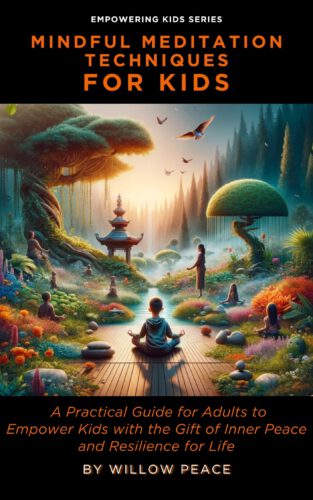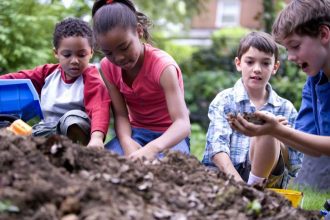Guest writer for Wake Up World
It is a disappointing thing to see new playgrounds developed in city spaces sit there empty each day, or to walk in the park and hear no laughter. What is missing here is not the children per se, but materials and environments that create challenge, imagination, and creativity that make children want to play outdoors. The absence of such play environments is not only influencing the quantity and quality of children’s play, but also affecting children’s health and well-being.
As adults, we need to support children in learning to enjoy what unstructured free play in the outdoors has to offer. We need to inspire imaginations, creative minds, and capable bodies. To do this, we can look toward two simple things: nature and adventure.
What’s Happening to Children’s Play?
Outdoor play is a necessary part of children’s development and is considered essential for children’s learning and wellbeing. Playing outdoors provides unique opportunities for learning that the indoor environment cannot offer. For example, children engage in higher levels of creativity, imagination, inventiveness, physical activity, language, and curiosity. Most importantly, they are given the opportunity to play freely. Despite this knowledge, outdoor play has been steadily decreasing for North American children.
When we look at why this disappearance of free play is happening, we realize that there are many factors that contribute to the lack of play. There are increases in structured play activities, an emergence of technology-based play objects, higher concerns related to safety and risk, adult control over children’s play activities, academically oriented schools, and an overall disregard for the value of play. More often than not, we see children engaged in a summer filled with structured sports activities, or stuck inside with gaming systems and cell phones. We hear adults saying “don’t pick up the sticks!”, “don’t play in the dirt!”, “don’t go too far!” and “be careful!”. We know that schools are decreasing recess time or taking it away all together.
Unfortunately, it is all too common that today’s society has an overall disregard for the value of play and how important it is for children of all ages. It is ultimately these factors that are placing a barrier between children and their right to play freely in the outdoors.
The inability to cross over this barrier is affecting children in many areas of development. For example, there are increases in anxiety and depression at younger ages as well as difficulties with emotional regulation and self-control. Increases in physical conditions such as diabetes, obesity, and asthma are becoming more apparent in young children and childhood disorders such as attention deficit hyperactivity disorder and obsessive-compulsive disorder are more frequently diagnosed. Children who do not have access to outdoor play will miss out on the many benefits that free play in the natural environment has to offer toward their growth.
Related reading: How Unstructured Play and Time in Nature Benefit a Child’s Development
The Importance of Free Play in the Outdoors
When children are engaged in free play in the outdoors, they are provided opportunities for freedom, choice, and fewer routines. In free play, there is no adult direction or control, so children are able to play how they want to play. When children are given such freedom to play, they are more likely to engage in higher levels of social interaction, cognitive skills such as decision-making and reasoning, empathy, and physical activity. In turn, they are less likely to become inattentive, anxious, or depressed and unhealthy.
The outdoor environment in particular has many benefits. A natural green space allows children to continuously explore ways to use materials, discover the varied environment, and create their own play experiences. The outdoor environment is not a man-made area and, therefore, is diverse and timeless. Children who play outdoors have heightened senses and emotions from the ever-changing topography and the rich stimuli that a natural space affords. This is how children learn – through experience: by seeing, feeling, touching, and hearing. The outdoor environment is a blank canvas on which children are able to place their own thoughts, wonders, and creations.
Related reading: Decline in Childhood Play Related to Rising Anxiety and Depression in Children, Adolescents
The Loose Parts Movement for Bringing Back Play
So what can be done now? After this discussion of the importance of free play in the outdoors you may be wondering how you can bring back play for children in your life. There are two things to support you in doing so: nature and adventure. What you are going to need to do is reintroduce adventure back into children’s outdoor play. To accomplish this, you can use loose parts.
Loose parts are play objects and materials that are open-ended, manipulative, moveable, and non-dictated. This means that children can use the materials in a variety of ways and there is no suggested way or “story” behind these materials. Loose parts allow children to act upon their environment the way that they want, rather than their imaginations and creativity being predetermined by the materials.
Examples of loose parts are items such as tires, logs, sticks, fabric, rope, chalk, and rocks. Loose parts can either be synthetic materials or materials that are commonly found in a natural outdoor environment. Loose parts spark children’s curiosity, which then leads to exploration and discovery. For example, if a child is provided with rope, tarp, and wooden pieces, she will become curious about what the materials are and how to use them. She will then begin to explore the materials in different ways through her imagination and creativity. This leads to discovering that the materials can do many things. This process of curiosity, exploration, and discovery is ultimately what leads to play and learning.
Related reading: It’s Time to Unleash Creativity in Our Schools
Where Can I Find Loose Parts?
You can find loose parts in many places, and they are often free!
- Parks, forests, and natural spaces
- Thrift stores
- Yard sales
- Hardware stores
- Fabric stores
- Local dairy suppliers
- Grocery stores
- Your own recycling bin
Here is a loose parts list that will inspire you to get out there and collect your own:
To support children in loving play again, it is important that we create environments and include materials that are fun, engaging, and challenging. If an environment or an object is too easy, children will view it as boring. To reintroduce adventure and free play to your children, consider using loose parts. When loose parts are paired with the outdoors, it will lift children’s spirits, make them love playing again, and ultimately make them happier and healthier.

Image courtesy of Fix.com
About the author:

If you've ever found value in our articles, we'd greatly appreciate your support by purchasing Mindful Meditation Techniques for Kids - A Practical Guide for Adults to Empower Kids with the Gift of Inner Peace and Resilience for Life.
In the spirit of mindfulness, we encourage you to choose the paperback version. Delve into its pages away from screen glare and notifications, allowing yourself to fully immerse in the transformative practices within. The physical book enriches the learning process and serves as a tangible commitment to mindfulness, easily shared among family and friends.
Over the past few years, Wake Up World has faced significant online censorship, impacting our financial ability to stay online. Instead of soliciting donations, we're exploring win-win solutions with our readers to remain financially viable. Moving into book publishing, we hope to secure ongoing funds to continue our mission. With over 8,500 articles published in the past 13 years, we are committed to keeping our content free and accessible to everyone, without resorting to a paywall.









